“It’s not right,” the restaurant owner scowled, starched cotton billowing over his belly. “It’s not right for a woman to pay when she has a man with her.”
Perhaps one day, I will be the kind of woman who can simply respond, “I’ll keep my money, then,” and walk away. But too many unjust words have clogged my arteries, and I cannot play at such coldblooded dignity.
She’s too educated. It’s not a good thing in a girl.
Women working; it’s against our culture.
Sure you’ll study marketing, you’ll go to the market when your husband tells you.
At that restaurant, years ago, my young voice rose and shook with an old rage against the man behind his counter. My friend had to drag me outside, to that stretch of Coney Island Avenue in Brooklyn known as Little Pakistan.
I call myself Brooklynstani, on my website and business cards. The moniker was never meant to be more than a half-joke: a reference to my neither-here-nor-there identity crisis. Sometimes, it’s my rebellion against the limiting question, “Where are you from?” As a Pakistani raised in Africa and the Middle East, I’ve never been able to answer my inquisitors to their satisfaction.
In Brooklyn, I’ve found a warren of shape-shifters like me. We’re all castaways from our native communities for being too willful, too strange, too subversive. So, I like to muse, we hail instead from a fictitious no man’s land, Brooklynstan, a dockside chaos of languages and swirling mists. Rather than a land mass, my Brooklynstan is a state of mind, liberated from geography. This is where I belong.
Except, the real Brooklynstan does have coordinates. Along Coney Island Avenue, it is approximately bordered by Avenue H to the south and Beverly Road to the north. Here, Brooklyn and Pakistan bleed into each other and form a new nation-state. The official language is a blend of Urdu and Punjabi slang, the costume shalwar kameez, hijab, prayer cap. The national anthem rings out five times a day from a storefront mosque. The cuisine is chicken kurma, saag panir, biryani, congealing behind steamy sneeze-guards for taxi drivers 24 hours a day.
My money is no good here. I may wear the clothes or speak the language, but something in my manner always betrays me as foreign. Despite my chosen title, I do not belong in Brooklynstan.
*
It’s the night before Eid al-Adha, the Muslim holiday commemorating Abraham’s willingness to sacrifice his son for God. I am in Little Pakistan in search of ingredients to cook sheer khorma, a traditional Eid dessert.
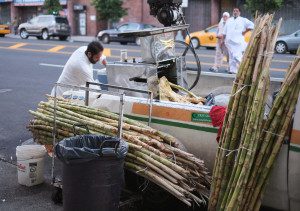 Though I live less than two miles away, I rarely venture out to Coney Island Avenue, hardened against the neighborhood by hostile glances and whispers over the years. This is a place for real Pakistanis, I decided long ago, not for the stumbling nomad picking and discarding identities like coats from her closet. And certainly, I’ve inferred from my experiences, brown women of Western clothing and gait are not welcome here. Admittedly, no part of this city truly welcomes such a woman. But I’ve preferred to avoid Little Pakistan, rather than risk rejection by these people in particular. Even though (or perhaps because) some might call them my people.
Though I live less than two miles away, I rarely venture out to Coney Island Avenue, hardened against the neighborhood by hostile glances and whispers over the years. This is a place for real Pakistanis, I decided long ago, not for the stumbling nomad picking and discarding identities like coats from her closet. And certainly, I’ve inferred from my experiences, brown women of Western clothing and gait are not welcome here. Admittedly, no part of this city truly welcomes such a woman. But I’ve preferred to avoid Little Pakistan, rather than risk rejection by these people in particular. Even though (or perhaps because) some might call them my people.
This evening, I’ve begun my visit to Coney Island Avenue along the southern end of the Pakistani neighborhood, near Avenue H. At twilight, the streets are emptier than I’d expected on a Friday night before Eid. Threading parlors shuttered, sidewalks littered with the detritus of earlier activity, as if a dark, windswept shell of a once splendid citadel.
At first, I’m disappointed: despite my reservations, I’d hoped for a festive atmosphere at this holiday season. But soon I spot at a lit jewel of a room below street level, and pause in the growing darkness to peer inside. Stairs lead from the sidewalk to a basement boutique, its ceiling windows uncovered. Inside, Eid finery is displayed on mannequins: georgette, satin, organza in shades of crimson, fuchsia, violet, embellished with gold thread, sequin, pearl. A few customers wander around the store, their chatter inaudible from my vantage point, but as tangible as silk between finger and thumb.
For a moment, I consider descending the steps, entering the basement’s warmth. But I am nervous of this half-hidden storefront. Perhaps I will be the wrong kind of Pakistani woman here, too. I make up my mind. Turning my jacket collar to the fall chill, I move on and continue up the street.
The neighborhood gathers life toward Newkirk Avenue. I pass several groups of women, their black abayas flapping in the breeze to reveal colorful tunics and ballet flats as they race across the avenue to make the light. Men in shalwar kameez, starched Friday fresh, linger outside restaurants, or pace while yelling Punjabi into their cell phones, jangling keys in pockets. In ballpoint Urdu, convenience stores announce goats available to reserve for Eid slaughter.
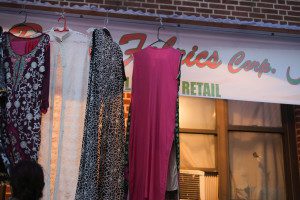 Next door to the hubbub of the giant Gourmet restaurant is another boutique, The House of Fashion. Maybe here, I’ll resist my anxieties and take a look around. A table at the door beckons me first with boxes of cheap, glittery jewelry. I pick up a set of rainbow-spangled bangles, attempting to determine whether they will fit my friend’s three-year-old daughter. A stooped, elderly man, the manager, hovers in the background. My instinct is to keep my distance, and I usually speak English with shop owners in the neighborhood. But something in me still craves connection. To be on the inside. I take a chance, greet the manager in Urdu and ask for his advice on sizing. But he shakes his head, aloof, tells me nothing more than the price before turning from me. My face warm, but lip stiff, I buy the bangles without another word and hurry away.
Next door to the hubbub of the giant Gourmet restaurant is another boutique, The House of Fashion. Maybe here, I’ll resist my anxieties and take a look around. A table at the door beckons me first with boxes of cheap, glittery jewelry. I pick up a set of rainbow-spangled bangles, attempting to determine whether they will fit my friend’s three-year-old daughter. A stooped, elderly man, the manager, hovers in the background. My instinct is to keep my distance, and I usually speak English with shop owners in the neighborhood. But something in me still craves connection. To be on the inside. I take a chance, greet the manager in Urdu and ask for his advice on sizing. But he shakes his head, aloof, tells me nothing more than the price before turning from me. My face warm, but lip stiff, I buy the bangles without another word and hurry away.
Nearby, outside what appears to be a travel agency, another display of jewelry catches my eye. Inside, a man dressed in trousers and button-down, behind a desk covered with multiple landlines and piles of paper, points behind him. His tiny office opens unexpectedly in the back to a cavernous, dusty space, filled with fabric and jewelry and bric-a-brac from Pakistan. He seems amused at my surprise, so I explain that I haven’t been to this store before. His response is smooth and rehearsed: no problem, he says, you’re welcome back all the time from now on.
A forlorn group of women, perhaps his wife and daughters, haunts the store’s depths. Their carpeted territory is oddly disconnected from the faded posters of mountains and beaches of the front office. They urge their ribbons and remnants at me, but, depressed by their listless air and the harsh lights, I leave as soon as politeness allows, avoiding the travel agent’s gaze on my way out.
Exhausted by this trip already, I head straight for a grocery store to purchase sheer khorma ingredients and head home. Here, I seek out packets of vermicelli, and with a pang of recognition, find the brand “National” that I remember from Pakistan. Sure enough, upon further examination, the dusty package is an import from Karachi.
At checkout, the cashier greets me with a smiled “Assalaam-o-Alaikum,” which I gladly return. He is young, speaks with an American accent, and I wonder if he has welcomed me more openly than most in the neighborhood because of these reasons.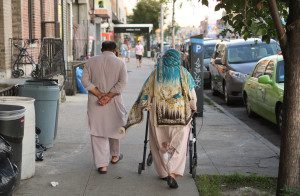 He rings up my items, and I hand him a twenty, which he takes with an emphatic “Bismillah ir-rahman ir-raheem”—the prayer of beginnings—“In the name of Allah, the beneficent, the merciful.” He places my twenty in the till, withdraws and returns my change, all while loudly enunciating the Arabic prayer at each instance of handling money.
He rings up my items, and I hand him a twenty, which he takes with an emphatic “Bismillah ir-rahman ir-raheem”—the prayer of beginnings—“In the name of Allah, the beneficent, the merciful.” He places my twenty in the till, withdraws and returns my change, all while loudly enunciating the Arabic prayer at each instance of handling money.
The women in my family whisper such sacred words as if sending private missives to the heavens. My grandmother’s breath was gentle against my forehead as her prayers swept dangers from me like so many cobwebs.
This man’s noisy proclamation, the invasion of his religion into my space, unnerves me. I’ve never before encountered this practice of praying aloud over money, not in Pakistan, nor anywhere else. Is this what being Pakistani means, now? Piety as currency, necessary at every transaction. My National vermicelli in hand, I leave the grocery store ever-more unsteady of my place.
Just outside, I find a rickety stall. Hand-painted Urdu lettering proclaims its wares: fresh paan, the little packets of prepared betel leaf chewed after dinner. My grandmother’s hands were so deft over her silver paan box, assembling her red and green treats with practiced rhythm. The same paan box my great-grandmother had presided over once, in a time before mine. Seized by nostalgia, I stop and greet the shriveled owner of this stall. His wrinkles are a map of his journey across the seas, a few gray hairs peek out beneath his askew wool cap, and his shalwar kameez is stained with yellow turmeric, red betel nut. He sets to work on my order with his containers of pastes and condiments and spices. Fingers nimble—a dash here, a sprinkle there—yet he is at work steadily for several minutes.
Two women, heads covered, robed in black, watch nearby as I wait for my paan. Their small children squirm in strollers beside them. The women steal curious looks at me every so often. One of the toddlers dumps his full bag of Takis on the sidewalk, and his mother scolds him roundly in Urdu, glancing sideways at me with the flutter of a laugh caught in her throat. I smile at her and the unconcerned child. The woman smiles back, a little surprised, shaking her head and shrugging as if to say, this is our lot.
Our lot. Perhaps, to her, she and I are connected, by our language, our feet on this foreign ground. The shape and color of the bodies we inhabit. Though so much separates us, too. I want to ask her how she came to live so far from home.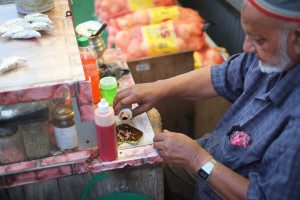 If she misses chand raat, the night before Eid, at her mother’s house, when her sisters would trace henna across her palms. Waking up early on Eid morning to hands stained bright and scented with the earth. I want to ask her whether she worries that her small son will grow into a Brooklynstani who rejects the world she knew.
If she misses chand raat, the night before Eid, at her mother’s house, when her sisters would trace henna across her palms. Waking up early on Eid morning to hands stained bright and scented with the earth. I want to ask her whether she worries that her small son will grow into a Brooklynstani who rejects the world she knew.
But the paan man has finished his task, and the moment slips away. He presents me with a triangle-fold of sharp green leaf bursting juice and fragrance within. The architecture of his gift is so old and so constant. Just as I remember.
I retrace my steps down Coney Island Avenue to return home. On my way, I’m drawn again to the table of shiny jewelry outside the House of Fashion, where I earlier bought bangles for a friend’s three-year-old. This time, I am emboldened to enter and explore the store, run my fingers over rolls of cotton fabric and block printed scarves. I realize soon that this is perhaps the one establishment in the neighborhood neither owned nor operated by Pakistanis. The proprietor, Malini, is Sri Lankan, and the elderly man I’d encountered outside speaks Sinhalese, rather than the Urdu I had assumed. He was not dismissive of me, then. Instead, I simply had not recognized him as yet another foreigner to this place.
I purchase purple and silver bangles for myself and a friend, chat with Malini as she cuts me generous swatches of fabric to take home and consider for curtains. I relax at the one store on this avenue occupied by fellow outsiders. The one place where I do not struggle against my primal desire to belong. Where I do not retreat into my Coney Island of the mind.
I walk past an old man dressed in white. He stops to glare at me. Turns around when I leave him behind. I imagine his hard eyes following me with disapproval.
Or maybe, he bears me no malice. Maybe I only resemble the daughter who has also left him behind. And he stares in disbelief that I could pass him by on this avenue, in our brand new world, without knowing him at all.
***
Original photographs © Shiva Muthiah.
Note: With apologies to Lawrence Ferlinghetti.
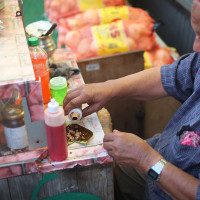



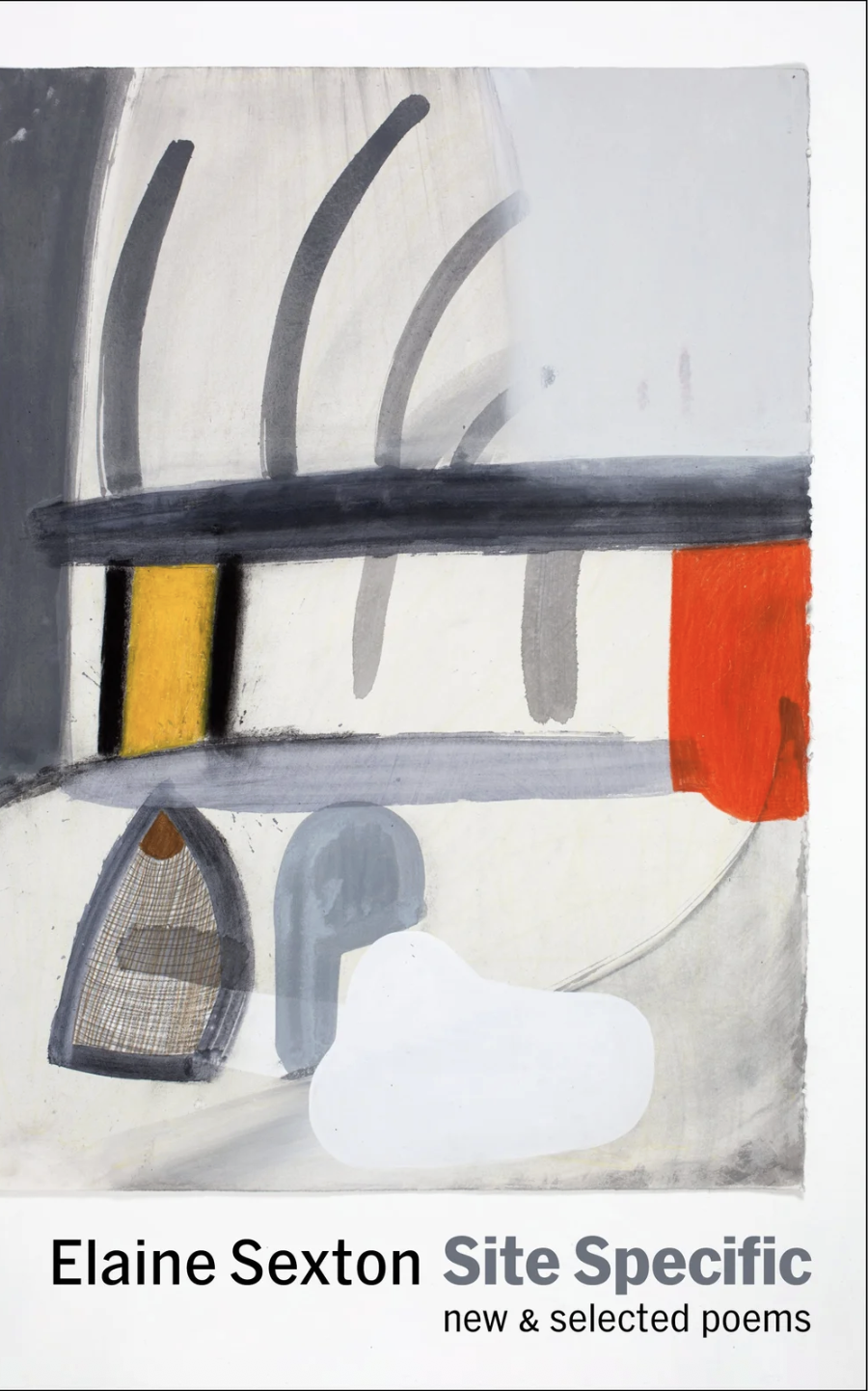
One response
Enjoyed reading, interesting walk down the shopping lanes of Coney Island.
Wanted to see some more pictures of the people there.
Click here to subscribe today and leave your comment.